Page 536 of 602
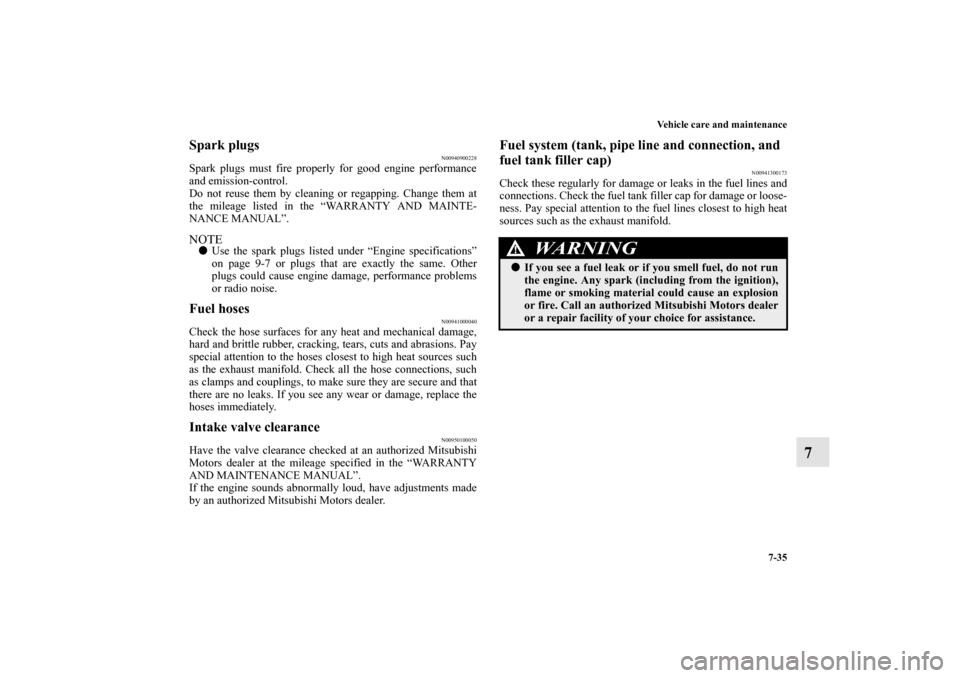
Vehicle care and maintenance7-35
7
Spark plugs
N00940900228
Spark plugs must fire properly for good engine performance
and emission-control.
Do not reuse them by cleaning or regapping. Change them at
the mileage listed in the “WARRANTY AND MAINTE-
NANCE MANUAL”. NOTE�Use the spark plugs listed under “Engine specifications”
on page 9-7 or plugs that are exactly the same. Other
plugs could cause engine damage, performance problems
or radio noise.Fuel hoses
N00941000040
Check the hose surfaces for any heat and mechanical damage,
hard and brittle rubber, cracking, tears, cuts and abrasions. Pay
special attention to the hoses closest to high heat sources such
as the exhaust manifold. Check all the hose connections, such
as clamps and couplings, to make sure they are secure and that
there are no leaks. If you see any wear or damage, replace the
hoses immediately.Intake valve clearance
N00950100050
Have the valve clearance checked at an authorized Mitsubishi
Motors dealer at the mileage specified in the “WARRANTY
AND MAINTENANCE MANUAL”.
If the engine sounds abnormally loud, have adjustments made
by an authorized Mitsubishi Motors dealer.
Fuel system (tank, pipe line and connection, and
fuel tank filler cap)
N00941300173
Check these regularly for damage or leaks in the fuel lines and
connections. Check the fuel tank filler cap for damage or loose-
ness. Pay special attention to the fuel lines closest to high heat
sources such as the exhaust manifold.
WARNING
!�If you see a fuel leak or if you smell fuel, do not run
the engine. Any spark (including from the ignition),
flame or smoking material could cause an explosion
or fire. Call an authorized Mitsubishi Motors dealer
or a repair facility of your choice for assistance.
BK0150700US.book 35 ページ 2012年3月22日 木曜日 午後6時46分
Page 538 of 602
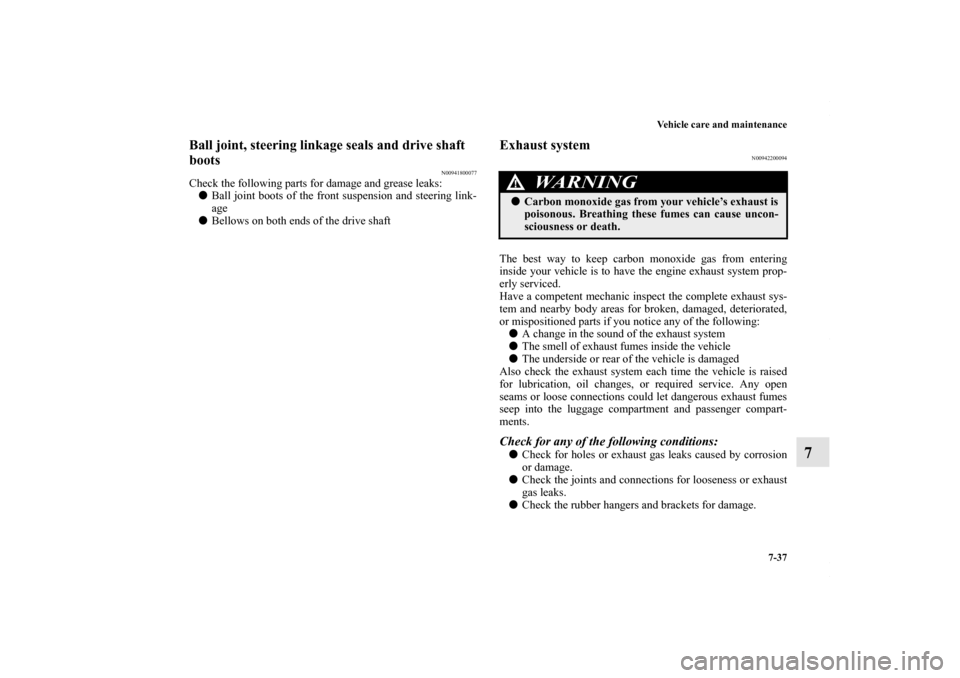
Vehicle care and maintenance7-37
7
Ball joint, steering linkage seals and drive shaft
boots
N00941800077
Check the following parts for damage and grease leaks:� Ball joint boots of the front suspension and steering link-
age
� Bellows on both ends of the drive shaft
Exhaust system
N00942200094
The best way to keep carbon monoxide gas from entering
inside your vehicle is to have the engine exhaust system prop-
erly serviced.
Have a competent mechanic inspect the complete exhaust sys-
tem and nearby body areas for broken, damaged, deteriorated,
or mispositioned parts if you notice any of the following:
� A change in the sound of the exhaust system
� The smell of exhaust fumes inside the vehicle
� The underside or rear of the vehicle is damaged
Also check the exhaust system each time the vehicle is raised
for lubrication, oil changes, or required service. Any open
seams or loose connections could let dangerous exhaust fumes
seep into the luggage compartment and passenger compart-
ments.Check for any of the following conditions:� Check for holes or exhaust gas leaks caused by corrosion
or damage.
� Check the joints and connections for looseness or exhaust
gas leaks.
� Check the rubber hangers and brackets for damage.
WARNING
!�Carbon monoxide gas from your vehicle’s exhaust is
poisonous. Breathing these fumes can cause uncon-
sciousness or death.
BK0150700US.book 37 ページ 2012年3月22日 木曜日 午後6時46分
Page 539 of 602
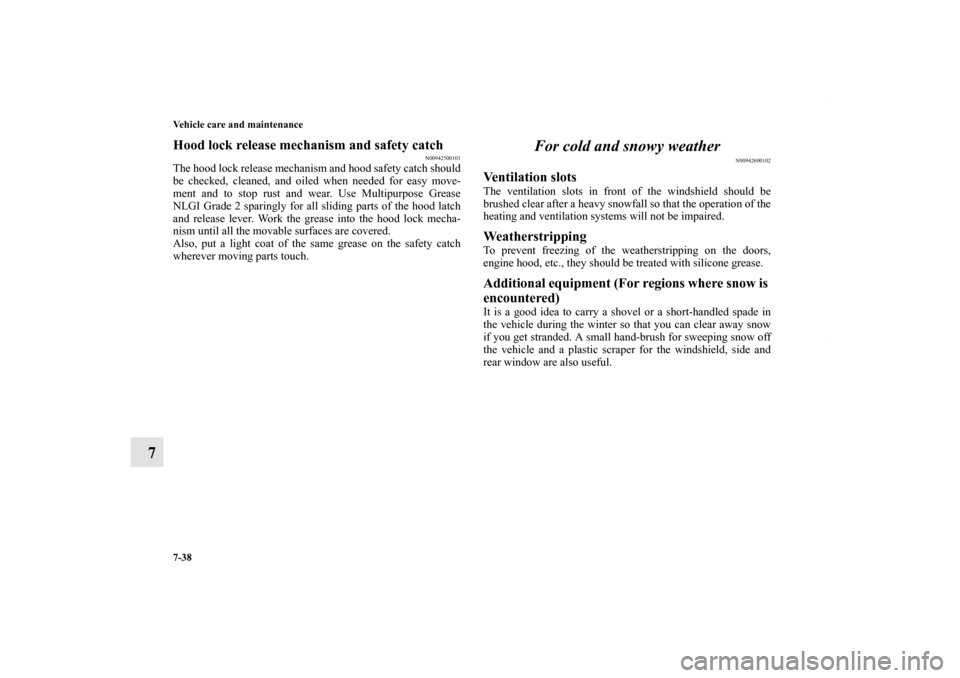
7-38 Vehicle care and maintenance
7
Hood lock release mechanism and safety catch
N00942500101
The hood lock release mechanism and hood safety catch should
be checked, cleaned, and oiled when needed for easy move-
ment and to stop rust and wear. Use Multipurpose Grease
NLGI Grade 2 sparingly for all sliding parts of the hood latch
and release lever. Work the grease into the hood lock mecha-
nism until all the movable surfaces are covered.
Also, put a light coat of the same grease on the safety catch
wherever moving parts touch.
For cold and snowy weather
N00942600102
Ventilation slotsThe ventilation slots in front of the windshield should be
brushed clear after a heavy snowfall so that the operation of the
heating and ventilation systems will not be impaired.WeatherstrippingTo prevent freezing of the weatherstripping on the doors,
engine hood, etc., they should be treated with silicone grease.Additional equipment (For regions where snow is
encountered)It is a good idea to carry a shovel or a short-handled spade in
the vehicle during the winter so that you can clear away snow
if you get stranded. A small hand-brush for sweeping snow off
the vehicle and a plastic scraper for the windshield, side and
rear window are also useful.
BK0150700US.book 38 ページ 2012年3月22日 木曜日 午後6時46分
Page 540 of 602
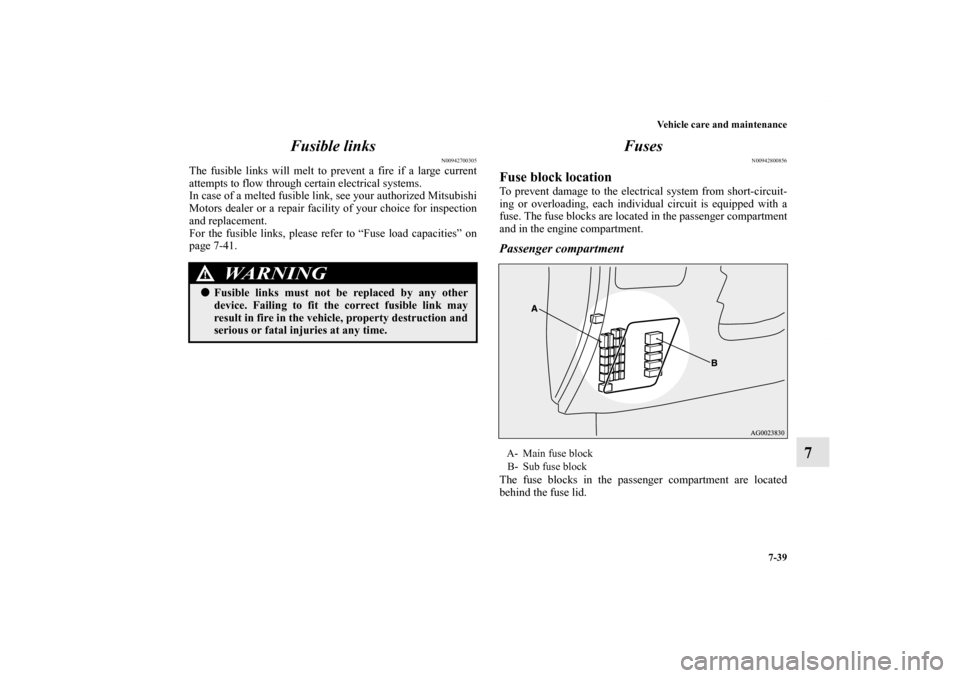
Vehicle care and maintenance7-39
7
Fusible links
N00942700305
The fusible links will melt to prevent a fire if a large current
attempts to flow through certain electrical systems.
In case of a melted fusible link, see your authorized Mitsubishi
Motors dealer or a repair facility of your choice for inspection
and replacement.
For the fusible links, please refer to “Fuse load capacities” on
page 7-41.
Fuses
N00942800856
Fuse block locationTo prevent damage to the electrical system from short-circuit-
ing or overloading, each individual circuit is equipped with a
fuse. The fuse blocks are located in the passenger compartment
and in the engine compartment.Passenger compartmentThe fuse blocks in the passenger compartment are located
behind the fuse lid.
WARNING
!�
Fusible links must not be replaced by any other
device. Failing to fit the correct fusible link may
result in fire in the vehicle, property destruction and
serious or fatal injuries at any time.
A- Main fuse block
B- Sub fuse block
BK0150700US.book 39 ページ 2012年3月22日 木曜日 午後6時46分
Page 542 of 602
Vehicle care and maintenance7-41
7
Engine compartmentIn the engine compartment, the fuse block is located as shown
in the illustration.Fuse load capacities
N00954800172
This fuse list shows the names of the electrical systems and
their fuse capacities.
There are spare fuses in the fuse block cover in the engine
compartment. Always replace a blown fuse with one of the
same capacity as the original.
Passenger compartment fuse location table
1- Push the lock lever.
2- Remove the fuse block cover.
Passenger compartment fuse location Sub fuse block
Main fuse block
BK0150700US.book 41 ページ
2012年3月22日 木曜日 午後6時46分
Page 544 of 602
Vehicle care and maintenance7-43
7
Engine compartment fuse location tableEngine compartment fuse location
Behind the fuse block cover
No.
Symbol
Electrical system
Capacity
1 Front fog lights 15 A
2 Engine7.5 A
3 Automatic transaxle 20 A
4 Horn10 A
5 Alternator7.5 A
6 Headlight washer 20 A
7 Air conditioning 10 A
8 ETV/Oil cooler fan
(Twin Clutch SST) 15 A
9 Security horn20 A
10 Wiper deicer15 A
11 — ——
12 Power gate30 A
13 Daytime running lights 10 A
14 Headlight
(high beam) (left) 10 A
15 Headlight
(high beam) (right) 10 A
16 Headlight
(low beam) (left) Discharge 20 A
BK0150700US.book 43 ページ
2012年3月22日 木曜日 午後6時46分
Page 546 of 602
Vehicle care and maintenance7-45
7
Identification of fuse
Fuse replacement
N00954900128
1. Before replacing a fuse, always turn off the electrical itemconcerned to the fuse and turn the ignition switch to the
“OFF” position or put the operation mode in OFF.
2. There is a fuse remover (A) in the engine compartment fuse block.
Capacity
Color
7.5 A Brown
10 A Red
15 A Blue
20 A Yellow
25 A Natural (white)
30 A Green (fuse type) /Pink (fusible link type)
40 A Green (fusible link type)
BK0150700US.book 45 ページ 2012年3月22日 木曜日 午後6時46分
Page 573 of 602
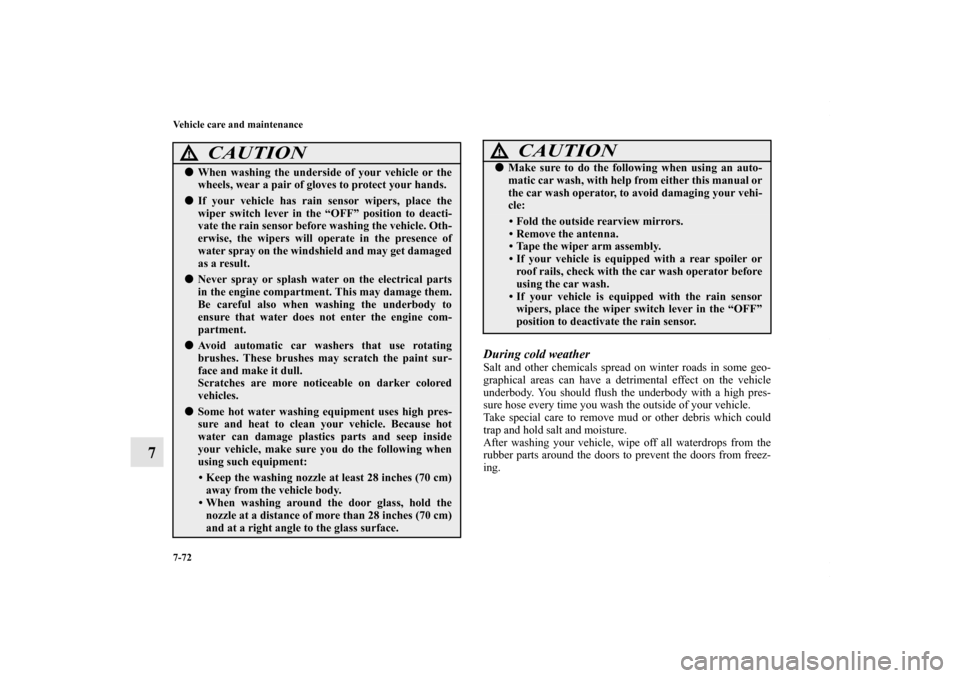
7-72 Vehicle care and maintenance
7
During cold weatherSalt and other chemicals spread on winter roads in some geo-
graphical areas can have a detrimental effect on the vehicle
underbody. You should flush the underbody with a high pres-
sure hose every time you wash the outside of your vehicle.
Take special care to remove mud or other debris which could
trap and hold salt and moisture.
After washing your vehicle, wipe off all waterdrops from the
rubber parts around the doors to prevent the doors from freez-
ing.
CAUTION
!�When washing the underside of your vehicle or the
wheels, wear a pair of gloves to protect your hands.�If your vehicle has rain sensor wipers, place the
wiper switch lever in the “OFF” position to deacti-
vate the rain sensor before washing the vehicle. Oth-
erwise, the wipers will operate in the presence of
water spray on the windshield and may get damaged
as a result.�Never spray or splash water on the electrical parts
in the engine compartment. This may damage them.
Be careful also when washing the underbody to
ensure that water does not enter the engine com-
partment.�Avoid automatic car washers that use rotating
brushes. These brushes may scratch the paint sur-
face and make it dull.
Scratches are more noticeable on darker colored
vehicles.�Some hot water washing equipment uses high pres-
sure and heat to clean your vehicle. Because hot
water can damage plastics parts and seep inside
your vehicle, make sure you do the following when
using such equipment:
• Keep the washing nozzle at least 28 inches (70 cm)
away from the vehicle body.
• When washing around the door glass, hold the nozzle at a distance of more than 28 inches (70 cm)
and at a right angle to the glass surface.
� Make sure to do the following when using an auto-
matic car wash, with help from either this manual or
the car wash operator, to avoid damaging your vehi-
cle:
• Fold the outside rearview mirrors.
• Remove the antenna.
• Tape the wiper arm assembly.
• If your vehicle is equipped with a rear spoiler or
roof rails, check with the car wash operator before
using the car wash.
• If your vehicle is equipped with the rain sensor wipers, place the wiper switch lever in the “OFF”
position to deactivate the rain sensor.CAUTION
!
BK0150700US.book 72 ページ 2012年3月22日 木曜日 午後6時46分